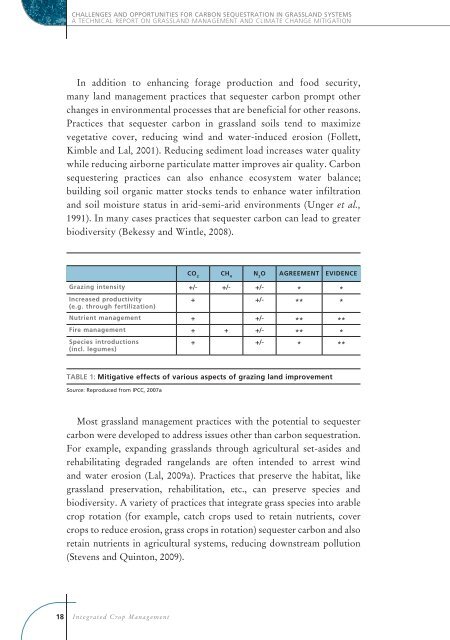<strong>Challenges</strong> <strong>and</strong> <strong>opportunities</strong> <strong>for</strong> <strong>carbon</strong> <strong>sequestration</strong> <strong>in</strong> grassl<strong>and</strong> systemsA Technical Report on Grassl<strong>and</strong> Management <strong>and</strong> Climate Change MitigationIn addition to enhanc<strong>in</strong>g <strong>for</strong>age production <strong>and</strong> food security,many l<strong>and</strong> management practices that sequester <strong>carbon</strong> prompt otherchanges <strong>in</strong> environmental processes that are beneficial <strong>for</strong> other reasons.Practices that sequester <strong>carbon</strong> <strong>in</strong> grassl<strong>and</strong> soils tend to maximizevegetative cover, reduc<strong>in</strong>g w<strong>in</strong>d <strong>and</strong> water-<strong>in</strong>duced erosion (Follett,Kimble <strong>and</strong> Lal, 2001). Reduc<strong>in</strong>g sediment load <strong>in</strong>creases water qualitywhile reduc<strong>in</strong>g airborne particulate matter improves air quality. Carbonsequester<strong>in</strong>g practices can also enhance ecosystem water balance;build<strong>in</strong>g soil organic matter stocks tends to enhance water <strong>in</strong>filtration<strong>and</strong> soil moisture status <strong>in</strong> arid-semi-arid environments (Unger et al.,1991). In many cases practices that sequester <strong>carbon</strong> can lead to greaterbiodiversity (Bekessy <strong>and</strong> W<strong>in</strong>tle, 2008).CO 2CH 4N 2O Agreement EvidenceGraz<strong>in</strong>g <strong>in</strong>tensity +/- +/- +/- * *Increased productivity(e.g. through fertilization)+ +/- ** *Nutrient management + +/- ** **Fire management + + +/- ** *Species <strong>in</strong>troductions(<strong>in</strong>cl. legumes)+ +/- * **Table 1: Mitigative effects of various aspects of graz<strong>in</strong>g l<strong>and</strong> improvementSource: Reproduced from IPCC, 2007aMost grassl<strong>and</strong> management practices with the potential to sequester<strong>carbon</strong> were developed to address issues other than <strong>carbon</strong> <strong>sequestration</strong>.For example, exp<strong>and</strong><strong>in</strong>g grassl<strong>and</strong>s through agricultural set-asides <strong>and</strong>rehabilitat<strong>in</strong>g degraded rangel<strong>and</strong>s are often <strong>in</strong>tended to arrest w<strong>in</strong>d<strong>and</strong> water erosion (Lal, 2009a). Practices that preserve the habitat, likegrassl<strong>and</strong> preservation, rehabilitation, etc., can preserve species <strong>and</strong>biodiversity. A variety of practices that <strong>in</strong>tegrate grass species <strong>in</strong>to arablecrop rotation (<strong>for</strong> example, catch crops used to reta<strong>in</strong> nutrients, covercrops to reduce erosion, grass crops <strong>in</strong> rotation) sequester <strong>carbon</strong> <strong>and</strong> alsoreta<strong>in</strong> nutrients <strong>in</strong> agricultural systems, reduc<strong>in</strong>g downstream pollution(Stevens <strong>and</strong> Qu<strong>in</strong>ton, 2009).18Integrated Crop Management
<strong>opportunities</strong>Practices that sequester <strong>carbon</strong> <strong>in</strong> grassl<strong>and</strong>scan enhance adaptation to climate changeMitigation <strong>in</strong>vestments are crucially important <strong>for</strong> reduc<strong>in</strong>g the impactsof climate change, but GHG concentrations will cont<strong>in</strong>ue to <strong>in</strong>crease<strong>for</strong> decades despite implementation of even the most aggressive climatepolicies (IPCC, 2007a). There<strong>for</strong>e, adaptation is an important responseto climate change that should beg<strong>in</strong> now (IPCC, 2007b). Because yieldreductions under drought, heat stress, floods <strong>and</strong> other extreme eventswill be the most consequential, negative impacts of climate change, ef<strong>for</strong>tsto adapt to a chang<strong>in</strong>g climate should focus on <strong>in</strong>creas<strong>in</strong>g the resilienceof management systems (<strong>FAO</strong>, 2008a; WMO, 2007). The <strong>in</strong>creas<strong>in</strong>gfrequency of droughts <strong>in</strong> the dryl<strong>and</strong>s (Thornton et al., 2008) <strong>and</strong> droughtsof longer duration are expected to have a substantial negative effect onthe susta<strong>in</strong>ability <strong>and</strong> viability of livestock production systems <strong>in</strong> semiaridregions. Grassl<strong>and</strong> management practices maximize the <strong>in</strong>filtration,capture <strong>and</strong> utilization of precipitation <strong>for</strong> production (Woodf<strong>in</strong>e, 2009).In cases where susta<strong>in</strong>able graz<strong>in</strong>g management <strong>in</strong>creases soil <strong>carbon</strong>stocks, soil water hold<strong>in</strong>g capacity <strong>in</strong>creases. Both facets of enhanc<strong>in</strong>gwater balance will <strong>in</strong>crease drought resilience.Grassl<strong>and</strong> management practices that sequester <strong>carbon</strong> tend to makesystems more resilient to climate variation <strong>and</strong> climate change: <strong>in</strong>creasedsoil organic matter (<strong>and</strong> <strong>carbon</strong> stocks) <strong>in</strong>creases yields (Vallis et al., 1996;Pan et al., 2006); soil organic matter also enhances soil fertility, reduc<strong>in</strong>greliance on external N <strong>in</strong>puts (Lal, 2009b). Surface cover, mulch <strong>and</strong> soilorganic matter all contribute to a decrease <strong>in</strong> <strong>in</strong>terannual variation <strong>in</strong>yields (Lal et al., 2007); <strong>and</strong> practices that diversify cropp<strong>in</strong>g systems,such as grass <strong>and</strong> <strong>for</strong>age crops <strong>in</strong> rotation, sequester <strong>carbon</strong> <strong>and</strong> enhanceyield consistency.Agricultural practices <strong>in</strong>tended to mitigate GHG emissions could<strong>in</strong>crease vulnerability to climate variation <strong>and</strong> climate change, if they<strong>in</strong>crease the energy supply from food production systems (e.g. to supplybiomass energy), or prevent arable l<strong>and</strong> from be<strong>in</strong>g cultivated (e.g.af<strong>for</strong>estation). Similarly, actions <strong>in</strong>tended to foster adaptation could leadto <strong>in</strong>creased emissions: e.g. <strong>in</strong>creased N fertilization (<strong>and</strong> N 2O release)to enhance yields or harvest of stover <strong>for</strong> conversion to biofuels (IPCC,Vol. 9–201019
- Page 1: Integrated Crop Management Vol. 9 -
- Page 4 and 5: The designations employed and the p
- Page 7: Executive SummaryImplementing grass
- Page 11 and 12: Chapter 2BackgroundGrasslands cover
- Page 13 and 14: ackgroundGrasslands are intensively
- Page 15 and 16: Chapter 3OpportunitiesCarbon seques
- Page 17 and 18: opportunitiesStephens et al., 2007)
- Page 19 and 20: opportunitiesMany management techni
- Page 21 and 22: opportunities1.31.21.11.00.90.8nomi
- Page 23 and 24: opportunitiesgrowing, suggesting co
- Page 25: opportunities©FAO/m. marzotnationa
- Page 31: Chapter 4ChallengesDeveloping worka
- Page 39 and 40: challengesinnovation by agricultura
- Page 41 and 42: Chapter 5The way forwardFoundations
- Page 43 and 44: the way forwardthe strategic object
- Page 45 and 46: the way forwardassess carbon seques
- Page 47 and 48: eferencesBoyd, E., Corbera, E. & Es
- Page 49 and 50: eferencesGifford, R.M., Cheney, N.P
- Page 51 and 52: eferencesLal, R., Kimble, J.M. & St
- Page 53 and 54: eferencesPaustian, K., Collins, H.P
- Page 55 and 56: eferencesSoussana, J.F., Allard, V.
- Page 57 and 58: AcknowledgementsIn April 2009, 20 i
- Page 59 and 60: Policy briefPastoralistsPlaying a c
- Page 61 and 62: policy briefMuch of the world’s g
- Page 63 and 64: policy briefpost copenhagen agricul
- Page 65 and 66: policy brief>N0 2 000 4 000kilomete
- Page 67: Challenges and opportunities for ca

















